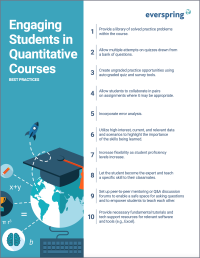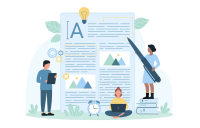Search
There are 25 results.
Category
Tag
Tag
All (62)
Active Learning (4)
Activities (3)
Analytics (4)
Assessments (6)
Asynchrony (5)
Backwards Design (1)
Canvas (7)
Case Studies (1)
Collaboration (3)
Communication (7)
Community (5)
Content Creation (12)
Course Maintenance (4)
Course Materials (3)
Course Preparation (4)
Discussions (4)
Faculty Presence (8)
Faculty Support (2)
Feedback (4)
Formative Assessments (5)
Game-Based Learning (2)
Gamification (1)
Generative AI (5)
Grading (3)
Images (1)
Multimodality (7)
Qualitative courses (1)
Quantitative courses (1)
Revising (2)
Rubrics (1)
Social Media (1)
Synchrony (6)
Third-Party Tools (1)
Universal Design for Learning (UDL) (1)
Video (1)
Visual Design (1)
Using Hotspots
A unique way to share information, images with hotspots offer online learners the opportunity to interact with course content. Learners can click or hover on particular parts of an image and receive pop-ups that give them more information. Hotspots represent information in a particular context; thus, they fulfill the multimedia principle—use words and graphics rather than words alone—and the contiguity principle—align words to corresponding graphics (Clark & Mayer, 2016).
Increasing Engagement With Announcements
Announcements are an essential aspect of online course engagement. When surveyed, students rated “sending regular announcements or email reminders” as one of the most beneficial engagement tactics that an instructor can employ (Martin & Bolliger, 2018, p. 216). In Canvas learning management system (LMS), announcements have a distinct advantage over inbox messages or whole-class emails, as announcements allow students to locate important course information in one convenient location, chronologically arranged. In contrast, email or inbox messages can become much more unruly, rendering information harder to find—especially after the course ends. In addition, most students should receive an email every time an instructor posts an announcement.
The Power of Retrieval Practice
Faculty aim to impart lasting knowledge and skills, but sometimes, learning doesn’t stick. One of the most powerful techniques for enhancing students’ long-term retention is retrieval practice, the process of actively recalling information to mind rather than passively reading or reviewing it. In this piece, we’ll dive into the evidence behind retrieval practice, provide strategies for how to incorporate it into online courses, suggest ways to frame its utility to students to ensure they fully reap the benefits of this learning strategy, and describe specific types of retrieval practice activities.
Types of Retrieval Practice Activities
By incorporating regular retrieval practice into your online course, you can ensure that key takeaways are actually being taken away by students to use in the future rather than being left behind due to lack of use. The following are some specific activities that can help move learners from a hazy recollection of something toward more clarity and permanence.
Game-Based Learning Experiences
Game-based learning (GBL) is a learning experience, or set of learning experiences, delivered through gameplay or game-like activities with defined learning outcomes. GBL is often confused with gamification, which is the application of game elements to a non-gaming experience. GBL engages students cognitively, emotionally, behaviorally, and socioculturally (Plass et al., 2015). Many factors should be considered when designing GBL, including narrative, player positioning, and interactive design (Dickey, 2005).
Canvas Grading and Feedback: What Students See
Did you know that some forms of assignment feedback in Canvas are more obvious to students than others? Canvas has a Student View option for instructors to get a sense of what students are seeing in most general areas of their courses, but it can be challenging to determine what your actual students are experiencing when accessing your comments on their work or the rubric you’ve filled out for their submission.
Student Support in a Multimodal Course
Multimodal courses allow for exciting opportunities in course content and activities but can be, by design, less flexible than asynchronous courses and less predictable than synchronous courses. These opportunities thus come with needs for additional logistical support and flexibility, as students need both to be able to take advantage of the opportunities of synchrony and asynchrony equitably. How can you best support students in a multimodal course, providing guidance through multiple forms of interaction? This piece gives insight into what kinds of support benefit students in multimodal courses and how to provide them. We’ll end with five quick tips for supporting students that apply to almost any multimodal course.
Using Synchrony and Asynchrony to Support A Guest Speaker
Hosting a guest speaker is not only a great pedagogical tool; it’s also a vivid example of the ways one mode of interaction can enrich the other in a multimodal course. Guest speakers can participate in a class synchronously (e.g., by participating in a synchronous session via online conferencing tools or in person) and/or asynchronously (e.g., by recording video or participating in asynchronous discussion boards). Students find asynchronous guest speakers easier to access, while synchronous speakers offer more opportunities for back-and-forth interaction between students and the guest (Alebaikan, 2016).
Instructor Presence in a Multimodal Course
Multimodal courses—courses that combine synchronous and asynchronous elements—offer many possibilities for instructor presence. Sometimes, however, more possibilities mean more confusion about what is best for your specific course. What does it mean to be a good instructor or facilitator? What kinds of things might an instructor do synchronously and asynchronously to showcase their personality and expertise?










